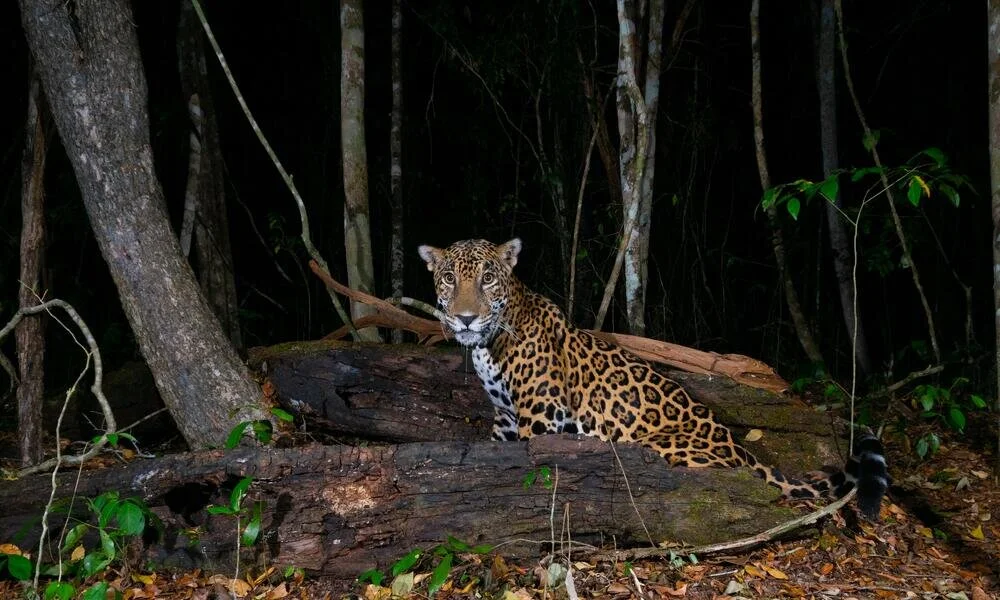Safari Journal - June 2021
JAGUARS - in Mesoamerica
THIS SERIES WILL BE POSTED periodically. WE WILL PRESENt here, Some of THE MOST CURRENT EFFORTS AND TECHNOLOGY BEING USED TO protect ENDANGERed ANIMAL species.
Jaguars, whose native Indian name, yaguara means “killer that takes its prey in a single bound”…
…nothing illustrates that better than the video here
Jaguars, whose native Indian name—yaguara—means “killer that takes its prey in a single bound,” tend to stalk prey on the ground, and, empowered by long hindlimbs, spring from ambush, killing with a single crushing bite through temporal skull bones. Pre-Columbian civilizations of Peru and Central America worshipped jaguars as gods, but overhunting for their beautiful spotted fur, as well as habitat destruction, has led to near-extinction over much of their range. They’re still found in remote forests and scrublands in Central and South America to Argentina.
Jaguars have eyesight that is six times better than that of humans at night and in darker conditions thanks to a layer of tissue at the back of their eyes that reflects light.
Jaguars that are black with spots are sometimes called panthers. They are actually jaguars.
Jaguars can hunt in water and wave their tails above water to attract fish.
Cockscomb Basin Jaguar Sanctuary - Belize
“Endangered jaguars, largest land predators in Central and South America and the hemisphere’s only cat of the Panthera genus (in which only the tiger and lion are bigger) are found here. These large, spotted cats—males here are typically around 125 pounds (60 kg)—have responded to safe haven in this 155 square miles (403 km2) of wild forest and mountains.” - Worldwide Safari Guide
The Lonely Jaguar of the United States
Conservationists have released video of the only known jaguar living in the country.
There are about 15,000 jaguars living in the wild today. They are solitary creatures, preferring to live and hunt alone. But the one living and hunting in the United States takes the word “loner” to another level: The jaguar, nicknamed “El Jefe,” is the only known wild jaguar in the country.
By: Marina Koren
Photography: Sutterstock
Historically, jaguars are not uncommon in Arizona. Their range once extended north from Argentina to Central America and Mexico and up into south-central states and even California and Louisiana. But the big cats all but disappeared from the U.S. in the last century, mostly due to habitat loss and federal population-control programs intended to protect livestock.
Scientists Identify 20 Million Acre Habitat Area for Jaguars in Arizona, New Mexico.
With former jaguar habitat converted to livestock ranches, jaguars, faced with diminishing food sources, began preying on livestock and other domestic animals. In turn, livestock producers increasingly retaliated against the jaguars. At least seven jaguars were killed in the last three years in La Palizada, a small town in Campeche in southeastern Mexico that is mostly dedicated to livestock production.
“This is the first electric fence installed in the area to help prevent conflicts between ranchers and jaguars and is part of WWF-Mexico’s project to ensure the protection of the jaguar population in the Maya Forest,” said Contreras.
How solar power is helping a community and jaguars
Managing human-wildlife conflict to reduce attacks and protect an at-risk population.
Wildlife in crisis
“Sometimes, nature conservation becomes much more, the jaguar also brought light into the family home—light for the kids to study, for the family to spend quality time together, and improve their well-being.”.
Jaguar scat study suggests restricted movement in areas of conservation importance in Mesoamerica
Río Plátano Biosphere Reserve
This outstanding nature set-aside has superb wildlife—jaguars, pumas, tapirs, manatees, scarlet macaws—also 200 sites of archeological importance covering almost 2,000 square miles (5,250 km2).
This non-invasive technique lets researchers gather large DNA sample sizes of difficult-to-study wildlife species, such as big cats, without physically capturing, handling, or disturbing the animals. Since these samples quickly degrade in the warm and humid conditions of the tropical countries, however, a great deal of laboratory work has to be done to successfully analyze the DNA.
A remote camera trap photo of a male jaguar at Pico Bonito National Park, Honduras. Credit: © Panthera-ICF
“We want to figure out ways to reconnect these populations or, even if they’re not completely isolated, to engage in activities that allow jaguars to move more freely across the landscape,” said George Amato, director of the Museum’s Sackler Institute for Comparative Genomics and the paper’s senior author. “One of the only ways to do this is through genetic analysis.”
If you found these articles interesting, check back for another edition in this series "Preempting Poachers - the new frontier". Please "like" our social media pages to be notified.
Advertisements
Tusk's approach to conservation recognizes that the long term future for wildlife and Africa's other natural resources is dependent on sustainable rural development. more... Tusk believes that if conservation is to succeed and environmental degradation to be reversed then education needs to be promoted at an early age.







